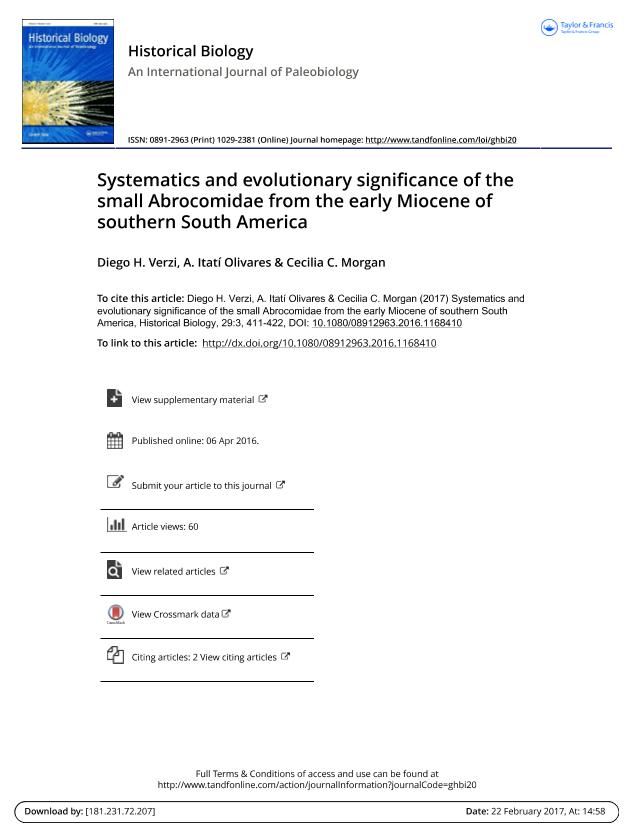Mostrar el registro sencillo del ítem
dc.contributor.author
Verzi, Diego Hector

dc.contributor.author
Olivares, Adriana Itati

dc.contributor.author
Morgan, Cecilia Clara

dc.date.available
2018-08-21T20:53:52Z
dc.date.issued
2017-04
dc.identifier.citation
Verzi, Diego Hector; Olivares, Adriana Itati; Morgan, Cecilia Clara; Systematics and evolutionary significance of the small Abrocomidae from the early Miocene of southern South America; Taylor & Francis; Historical Biology; 29; 3; 4-2017; 411-422
dc.identifier.issn
0891-2963
dc.identifier.uri
http://hdl.handle.net/11336/56470
dc.description.abstract
Octodontoidea is the most species-rich clade among hystricomorph rodents, and has a fossil record going back to at least the late Oligocene. Affinities of fossils previous to the late Miocene differentiation of the extant families Abrocomidae, Echimyidae and Octodontidae are controversial, essentially because these fossils may share few apomorphies with modern species. In fact, pre-late Miocene representatives of Abrocomidae had not been recognised until very recently. Here we revise the early Miocene genus Acarechimys, originally assigned to Echimyidae, and alternatively to stem Octodontoidea or to Octodontidae. A systematic and parsimony-based phylogenetic analysis of the species traditionally included in Acarechimys showed that this genus is part of stem Abrocomidae. These results are primarily supported by morphology of the mandible and lower molars. Acarechimys is here restricted to three species, A. minutus, A. pulchellus and Acarechimys pascuali sp. nov., while another species, A. constans, is here transferred to a new abrocomid genus. The remaining species were nested within Octodontidae. According to these results, Abrocomidae might have been as diverse as its sister clade Octodontidae-Echimyidae during the late Oligocene–early Miocene. Extinction of this diversity would have resulted in marked loss of evolutionary history, with extant abrocomids being currently restricted to late-diverged euhypsodont representatives.
dc.format
application/pdf
dc.language.iso
eng
dc.publisher
Taylor & Francis

dc.rights
info:eu-repo/semantics/openAccess
dc.rights.uri
https://creativecommons.org/licenses/by-nc-sa/2.5/ar/
dc.subject
Early Miocene
dc.subject
Octodontoidea
dc.subject
Phylogeny
dc.subject
Rodentia
dc.subject
South America
dc.subject.classification
Paleontología

dc.subject.classification
Ciencias de la Tierra y relacionadas con el Medio Ambiente

dc.subject.classification
CIENCIAS NATURALES Y EXACTAS

dc.title
Systematics and evolutionary significance of the small Abrocomidae from the early Miocene of southern South America
dc.type
info:eu-repo/semantics/article
dc.type
info:ar-repo/semantics/artículo
dc.type
info:eu-repo/semantics/publishedVersion
dc.date.updated
2018-08-21T18:39:27Z
dc.identifier.eissn
1029-2381
dc.journal.volume
29
dc.journal.number
3
dc.journal.pagination
411-422
dc.journal.pais
Reino Unido

dc.journal.ciudad
Londres
dc.description.fil
Fil: Verzi, Diego Hector. Universidad Nacional de La Plata. Facultad de Ciencias Naturales y Museo. División Zoología de Vertebrados. Sección de Mastozoología; Argentina. Consejo Nacional de Investigaciones Científicas y Técnicas; Argentina
dc.description.fil
Fil: Olivares, Adriana Itati. Universidad Nacional de La Plata. Facultad de Ciencias Naturales y Museo. División Zoología de Vertebrados. Sección de Mastozoología; Argentina. Consejo Nacional de Investigaciones Científicas y Técnicas; Argentina
dc.description.fil
Fil: Morgan, Cecilia Clara. Universidad Nacional de La Plata. Facultad de Ciencias Naturales y Museo. División Zoología de Vertebrados. Sección de Mastozoología; Argentina. Consejo Nacional de Investigaciones Científicas y Técnicas; Argentina
dc.journal.title
Historical Biology
dc.relation.alternativeid
info:eu-repo/semantics/altIdentifier/doi/http://dx.doi.org/10.1080/08912963.2016.1168410
dc.relation.alternativeid
info:eu-repo/semantics/altIdentifier/url/https://www.tandfonline.com/doi/abs/10.1080/08912963.2016.1168410
Archivos asociados
